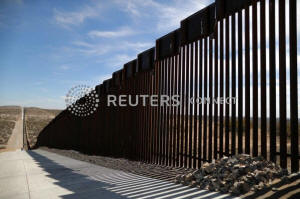|
Trump 'wall' in desolate stretch of New
Mexico has some asking: Why here?
 Send a link to a friend
Send a link to a friend
 [March 15, 2019]
By Andrew Hay and Richard Cowan [March 15, 2019]
By Andrew Hay and Richard Cowan
SANTA TERESA, New Mexico/ WASHINGTON
(Reuters) - The 18-foot-tall steel slats extend 20 miles across the
rugged Chihuahuan desert in southern New Mexico, cutting through high
sand dunes and brush.
On a recent day, there were none of the usual signs of migrant traffic -
no discarded water bottles, clothes or trash. The radio on a Border
Patrol SUV driving along the divide was mostly silent.
To many locals and public officials familiar with the area, the
$74-million structure just west of tiny Santa Teresa marks a surprising
priority in the Trump administration’s efforts to build a wall against
illegal immigration, drugs and human trafficking.
"Most of us here say why spend that money? Just dead money going into
the middle of the desert," said Jerry Pacheco, president and CEO of the
Border Industrial Association, a nonprofit representing industries in
southern New Mexico.
The barrier, completed last year, provides an early peek at the
administration’s efforts to provide the layer of national security
President Donald Trump’s supporters demand. Although the fence does not
break new ground – it replaces less formidable vehicle barriers - it is
the longest section erected to date under Trump, who has said generally
that he is starting in the most important places.

During more than two dozen interviews by Reuters reporters with the
project’s opponents and advocates, few described the Santa Teresa
stretch as having been a hub of illegal activity. Residents said they
had found evidence of drug smuggling, such as packages of marijuana and
other drugs dumped in the desert, and had seen individuals or small
groups of migrants cross from time to time.
During a recent tour along the Santa Teresa-area wall – or fence, as
some call it – a U.S. Border Patrol official explained to a Reuters
reporter why the project was necessary.
"This was an extremely popular place for both drugs and people," said
supervisory agent Joe Romero, referring to the stretch next to New
Mexico Highway 9 where the rust-brown slats rise above mesquite trees
and soaptree yuccas.
The agency would not provide figures for migrant apprehensions by the
Santa Teresa station before and after the wall was built.
Romero confirmed the Santa Teresa area was not typically a destination
for the large groups of immigrants from El Salvador, Honduras and
Guatemala seeking asylum in the United States. That is the group Trump
has mainly been targeting.
But Romero said the Santa Teresa fence allows the border patrol to
police the area with fewer agents and shift manpower to nearby urban and
semi-urban areas where the most migrants are now illegally crossing.
With agents tied up by large numbers of asylum seekers and their
humanitarian needs, the under-staffed agency needs the extra personnel
in areas where smugglers are taking advantage of these distractions,
Romero said.
A ‘STATE OF EMERGENCY’
Trump's proposed “great wall” extending along the border has come to
define his presidency, just as Trump Tower has defined his real estate
brand. He cites "an invasion of drugs, invasion of gangs, invasion of
people" and says the only way to put a stop to it is a hard barrier
along much of the 2,000 mile (3,200 km) southwest border.
Around 650 miles (1,046 km) of barriers already exist.
The problem for the president is that while his Department of Homeland
Security selects possible building sites, including Santa Teresa, the
administration generally needs Congress to appropriate the money. And
Congress has balked at the billions Trump wants.
On Feb. 15, the president declared a national emergency, which he said
would allow him to seize federal funds already appropriated for other
programs and use them to build the wall.
On Thursday, the Senate voted to terminate that declaration, setting up
an avowed veto by Trump that will be difficult for lawmakers to
override.
Amid the political warfare, Santa Teresa is the first significant
project to materialize under the president's watch.
Critics in Congress, including some Republicans, say the project was
about politics, not protection.
[to top of second column]
|

New bollard-style U.S.-Mexico border fencing is seen in Santa
Teresa, New Mexico, U.S., March 5, 2019. REUTERS/Lucy Nicholson

"They're sending a message - they're not trying to meet operational
security needs," said U.S. Senator Martin Heinrich, a New Mexico
Democrat, of politicians who favored the project.
Others say expanding on existing barriers provides a relatively
quick, easy way for the administration to argue that Trump is
delivering on his 2016 campaign promise.
Gabriel Vasquez, a Democrat who serves on the city council of nearby
Las Cruces, noted that the relatively small population in the Santa
Teresa area meant the project would meet little public resistance.
And the federal government already owned most of the land around the
border there so did not have to spend time and money buying it from
private ranchers or other landholders.
At least one other site for wall-building also is proposed in a
desolate location: According to the Washington Post, the Trump
administration plans a 31-mile barrier adjacent to a bombing range
in the Arizona desert.
Democrat Tom Udall, the other U.S. senator from New Mexico, said he
pressed federal officials to justify the Santa Teresa project before
construction started.
"'What is the pressure on this particular area, why are you doing
that?’” he recalled asking. “And they said, 'Oh in 2012 there were
300 people and in 2017 there were 500 that they know that crossed"
illegally, Udall said.
By comparison, more than 300,000 migrants were apprehended in 2017
across the entire southern border.
Instead of building large, expensive barriers in remote areas, Udall
and Heinrich say it makes more sense to invest federal dollars in
high-tech detection equipment there.
They also want to improve infrastructure and inspections at the
major ports-of-entry, including El Paso (about 15 miles southeast of
Santa Teresa), where experts say the bulk of drug smuggling occurs.
Gil Kerlikowske, who was the U.S. Customs and Border Protection
commissioner from 2014-2017, suggested that the emphasis on erecting
physical barriers was recent.
During his tenure, Kerlikowske said, agents at southwest border
stations spoke of the need for a big bag of tools: Predator drones,
boats, helicopter support, remote video, ground sensors, research
and development of tunnel detection and agents on horseback, ATVs
and motorcycles.
"Border Patrol never mentioned walls” then, he said.

DEFENDERS OF THE WALL
Locally, however, the Santa Teresa fence has some defenders.
Former U.S. Representative Steve Pearce, now the chairman of the
Republican Party of New Mexico, said that ranchers on the border
with Mexico want a wall on their properties, believing it will not
only stop immigrants from interfering with their livestock
operations but also protect their families from violent drug
cartels.
Pearce, an early Trump supporter, added, "I have always felt that
the wall by itself has got to be supplemented” with a range of
border enforcement tools, from more agents to technology.
Rancher Chip Johns, who said he has found bales of drugs dropped by
fleeing smugglers and who sleeps with a gun by his bed, said he felt
safer with the fence running along his 250,000-acre property. He
hopes it marks just the beginning of a more extensive project.
To stop the wall after 20 miles, allowing drug smugglers to cross
where it ends, would be “ridiculous,” he said.
(Andrew Hay reported from Santa Teresa, New Mexico and Richard Cowan
from Washington; Additional reporting by Jane Ross and Lucy
Nicholson; Editing by Julie Marquis and Marla Dickerson)
[© 2019 Thomson Reuters. All rights
reserved.]
Copyright 2019 Reuters. All rights reserved. This material may not be published,
broadcast, rewritten or redistributed.
Thompson Reuters is solely responsible for this content. |